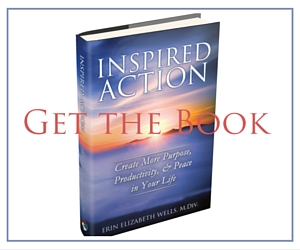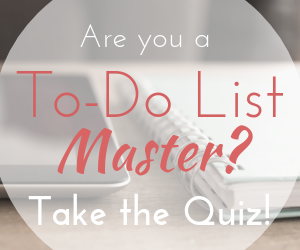It’s been said many times before, “If you don’t set your agenda, then someone else will do it for you.” Managing our focus and controlling our agenda is one of the most essential skills for any entrepreneur in this high distraction world. Everything tries to pull us away from what’s most important to us and our success.
That’s why I wanted to share another excerpt from my book Inspired Action: Create More Purpose, Productivity, and Peace in Your Life. This is Chapter 11: Action or Reaction Mode, which focuses on helping you first become aware of how often you are constantly reacting to various stimuli in your life, and then walks you through a process to create the necessary space to break that pattern and start acting and responding more intentionally.
When might you need this?
- When your phone text alert dings, and you automatically reach for it even though you were in your work groove moments before.
- When your new email alert goes off, and you pop open your inbox to see what’s there.
- When your client gives you some direct feedback, and you immediately feel defensive.
- When your flight is delayed, and you immediately get emotionally triggered and upset.
- SO many different places in our daily lives…
So, let’s dive in and talk about how you can create more space to start choosing your response intentionally…
Action or Reaction Mode?
Imagine this scenario: You have carefully planned what you want to do first thing tomorrow morning. You’re going to start that important project you’ve been thinking about for months. When morning comes, and you’re just about to take that first step, you check your email and get detoured into a lengthy response to your boss about what she perceives is a major issue in an upcoming presentation. After that, the phone rings with a call from your child’s school principal, who requests a meeting to discuss some concerns…and this turns into a lengthy conversation in which you cover most of the information that you will likely cover again in the meeting. Finally, just to add salt to the wound, you open the fridge to find there is no milk for your coffee, so you decide to run down the street to the café for a latte. Upon returning from the café you look at the clock and discover that it’s already 1 PM. Frazzled, you moan, “Where did my great morning work time go?”
Have you ever had mornings like this one? Does it feel like you often get derailed before you even get started? In today’s life, it has become absurdly easy to live in constant reaction mode. We run, hop, and jump when the phone rings, when the email dings, and when the laundry buzzer zings, and whatever important or purposeful action we were doing—or, worse, intending to do—gets left by the wayside.
It’s so easy to forget that we don’t need to be automatons responding to the stimuli of every sound or request around us. We have one supreme power that is entirely in our control: the power to choose what gets our attention in this moment. Granted, when your child is crying or your boss is yelling at you about something, it’s hard not to give that your full attention, but in so many other, smaller circumstances we allow ourselves to become derailed by much less important and even irrelevant items.
Stephen Covey writes about this power to choose in his book The 8th Habit: From Effectiveness to Greatness. While on sabbatical in Hawaii prior to working on his first major bestseller, The 7 Habits of Highly Effective People, he went to a library and wandered the stacks. He pulled a book off the shelf at random, (Victor Frankl’s Man’s Search for Meaning, as it happens) and in it he read three sentences that inspired much of his impressive thought-leadership:
Between stimulus and response there is a space.
In that space lies our freedom and power to choose our response.
In those choices lie our growth and our happiness.
The greatest skill we can learn is to expand the space between stimulus and response and exercise our freedom to choose our response—to choose what gets our attention in this moment and to choose what happens next. This means living in action mode rather than reaction mode. This skill is essential to develop if we want to live more “on purpose” because so many aspects of our lives are designed to interrupt and distract us, and it’s so easy to simply allow ourselves to go with the flow. The inevitable question becomes: how do we start to acquire this skill? It’s as simple as A, B, C, and D.
Step 1: Awareness
To start developing the ability to choose your responses, simply become aware of that space between stimulus and response. The next time something dings, rings, flashes, or knocks on your door, before you jump to your standard reactive response, just pause. Feel the space. Take a breath. Just notice how strong your urge to react is. Then, if necessary, continue with the automatic action you were inclined to take. Try this several times today and just notice how “big” your space is. How strong are your automatic responses? Their strength might differ depending on the stimulus. You might want to continue this awareness practice for a few days to explore and discover more.
Step 2: Brainstorm
After spending some time feeling and becoming aware of your space, choose one experience to reflect on. For example, let’s start with the “new message” notification sound on your computer’s email program. Now, completely outside of that moment when it dings, consider your options. What choices do you have when you hear that sound next time? Here are a few:
- Stop what you’re doing and see what has come in
- Ignore the sound and keep doing what you were doing
- Go into your email program’s sound settings and turn off the notification
- Chuck your computer out the window
Can you think of others? Even extreme options might be worth considering. Brainstorming has no limits after all!
Step 3: Choose
Consider all of the possible responses you brainstormed. Think about the possible consequences of each choice. Are the consequences life-threatening or job-threatening? Could you handle the consequences mentally and emotionally if they became problematic? What is the likelihood that your new response will lead to a dramatically bad outcome? What would you gain by making this choice?
Now, to continue with our example, choose a response to try the next time your new email notification dings. Commit to the choice, and get ready for the opportunity to make it.
Step 4: Do
The next opportunity has arisen: your email program dings its cheerful “new mail” noise. So, take that breath, feel that space, and make your new choice. What happens? Is there an immediate difference? Perhaps in how you feel or in what happens next? What are the actual consequences over the next couple hours or days? Are they catastrophic? If not, then try the same response again. Or, go back to the Choose step, choose a different possible response, and try that one next time. Wash, rinse, and repeat until you have changed your automatic programming and expanded your ability to choose in that moment.
Following Up
If you have success with small changes, such as responding to your email notifications in a new way, then apply the same process to other circumstances—the phone ringing, the doorbell, your phone’s text notifications, your child’s insistent requests, your partner’s less appealing personal habits…anything. As Frankl reminds us, between every stimulus and response there is a space, and in that space lies your power to choose.
It can also be helpful to reflect on what the ABCD process reveals about you. Does it help you realize that you have been acting out of fear or out of habit? If you can identify where your standard response is coming from, then you’ll be able to bring the right resources to bear to change it. If it’s a fear, then challenge your belief about the possible frightening consequences, and, if appropriate, seek the help of a counselor or coach. If it’s a habit, then it’s time to change the pattern in your brain by repeating the ABCD process consistently. For more help, you can take a look at Chapter 14: Habits: The Power of Patterns. With enough practice you’ll shift the balance in your life and increase your ability to act with purpose.
Next Actions
- Learn more about what the space between stimulus and response looks like for you. Stephen Covey believed that the “size” of your space comes largely from your family and your environmental conditions. Some people go through life with very large spaces between stimulus and response. Others, because of their personality, upbringing, or environmental circumstances, have been conditioned to have very small spaces and thus tend toward knee-jerk, automatic reactions. The size of your space might also vary in different areas of your life. Perhaps at home your space is larger, while at work it tends to be rapid-fire reactive—or vice versa. Is your space different around certain people or members of your family? Give yourself time just to learn about your own space without judging or trying to make any changes.
- Grab a piece of paper and write “Chances to Choose” at the top. Then brainstorm a list of all the events or moments during a typical day or week when you are in reaction mode or are functioning on autopilot as you respond to stimuli. If necessary, carry the list with you for the next day, and at each break in the day reflect on whether any additional reaction moments could be added to your list. Each of these items is an opportunity for you to exercise your own power of choice. Pick one item, and experiment with the ABCD process for the next couple days.
- Set a goal for yourself. If you have experimented with making a more proactive choice in one type of circumstance, then set a goal to repeat your new response for an entire day, a week, or a month—whatever feels appropriate. It’s best to start small and then build on your previous successes. If you relapse into your automatic response, don’t beat yourself up; just recommit to your new response for next time. New habits take some attention to build, and the best way to succeed is through commitment, clear actions and goals, and a resilient attitude.
If you have not yet picked up a copy of Inspired Action: Create More Purpose, Productivity, & Peace in Your Life, then grab your copy today!
Check out this recent Facebook Live for more information about this topic:



